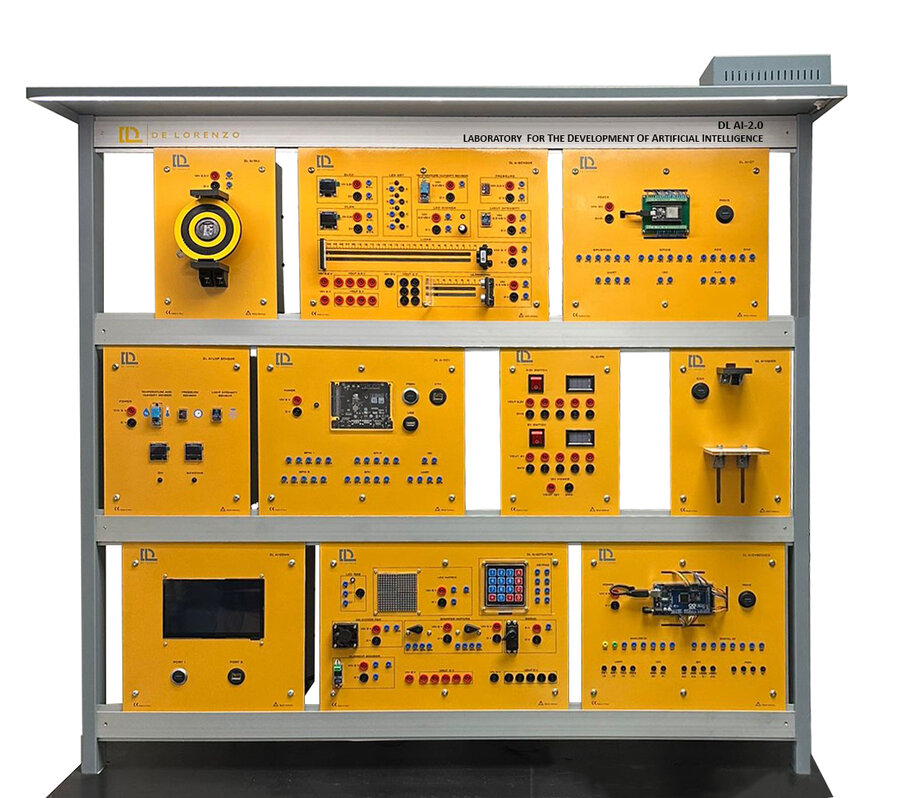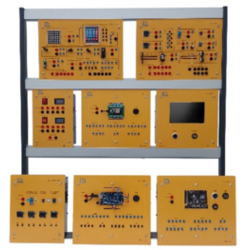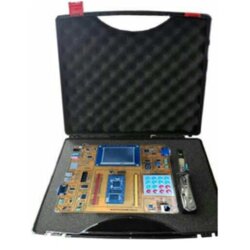Laboratory For The Development Of Artificial Intelligence (DL AI-2.0)



PL-660871
This didactic laboratory DL AI-2.0 for the development of Artificial Intelligence solutions is a state-of-the-art platform designed to provide practical and complete experience in the development of Artificial Intelligence solutions. With software and hardware that allow students to illustrate real-life scenarios, they will develop a comprehensive understanding of problem-solving from an AI perspective.
The laboratory DL AI-2.0 is mainly composed of a system with hardware modules with the support of a Server on which all the software related to AI field is installed. Three students can work on it performing all the experiments and the proposed training objectives with the help of the provided software’s as listed at the end of this catalogue in “SOFTWARE APPLICATIONS” & “TRAINING OBJECTIVES”. Even the three students who work with the HW need their own PC.
This lab also allows to increase the student’s number, up to 17 (becoming 20 students total), to work on it at the same time (with access to the Server from their own PCs) by providing a single license each. This additional license (when and if needed) has the following code DL AI-2.0SW. Please refer to other suggested configurations at the end of this catalogue.
PEDAGOGICAL APPROACH
In the didactic laboratory for the development of Artificial Intelligence solutions, the challenge-based learning (CBL) approach focuses on providing students with practical, real-world challenges that allow them to apply theoretical knowledge in specific situations. Rather than simply presenting information passively, this approach engages students in solving problems and creating innovative solutions. Students are faced with challenges that simulate real-life and industry problems, such as process optimization, anomaly detection or efficiency improvement. Using the hardware and software available in the lab, as well as artificial intelligence tools, students work in teams to develop practical solutions that address these challenges.
MAIN CHARACTERISTICS
- Multidisciplinary: Useful for the study of software development, artificial intelligence.
- Economic: By involving several disciplines, the cost of the product can be divided among different departments.
- Open: Provides the architecture to implement standard and new solutions, allowing the use of the product in professional and research activities.
- State-of-the-art: The product provides a descriptive view of software architecture for development using artificial intelligence.
MAIN DIDACTIC CONCEPTS
- AI basics.
- Machine Learning (ML).
- Sensors and actuators as data sources.
- Data processing and analysis.
- Programming and AI tools.
- Industrial applications.
SIMULATED INDUSTRIAL CHALLENGES
- Lighting management.
- Quality control.
- Process automation.
- Detection.
- Predictive maintenance.
- Condition monitoring.
- Optimization.
WHO IS IT FOR?
Schools, Academia and Industry (to validate theory and test concepts):
- Automation Engineer
- Software Engineer
- Mechatronics Engineering
- Process Engineering
- Information Technology
- Technical and Vocational Education and Training (TVET)
ELEMENTS THAT COMPOSE IT
IoT MODULE (NodeMCU)
- They promote learning of key concepts of electronics, IoT, automation, and embedded programming and AI.
- They facilitate the connection and testing of analog and digital sensors (temperature, humidity, light, proximity, etc.).
- They use banana terminal blocks to facilitate wiring without the need for soldering.
- They provide learning about ADC/DAC converters.
- They provide knowledge on Microcontroller programming.
- They us GPIO control for reading inputs and outputs.
- They use PWM signal generation.
- They use interrupts for real-time events.
- They use MQTT and HTTP protocols for communication.
- They create Wi-Fi sensors.
- They use actuator control.
- They facilitate interaction with Node-Red environment.
- They facilitate implementation of AI models.
AI DEVELOPMENT MODULE (Jetson NANO NVIDIA)
- They promote learning of key concepts of electronics, IoT, automation, and embedded programming and AI.
- They facilitate the connection and testing of digital sensors (temperature, humidity, light, proximity, etc.).
- They use banana terminal blocks to facilitate wiring without the need for soldering.
- They provide learning about DAC converters.
- They support for I2C, SPI, and UART protocols.
- They support development in Python.
- They us GPIO control.
- They use PWM signals control.
- They support real-time event and outage handling.
- They support real-time image processing.
- They facilitate implementation of neural networks.
- They support computer vision.
- They support HTTP integration.
- They support interaction with Node-Red.
- They support interaction with DC Motor Control, Servos and Stepper Motor.
- They facilitate the use of LIDAR.
EMBEDDED DEVELOPMENT MODULE (ARDUINO MEGA)
- They promote learning of key concepts of electronics, IoT, automation, and embedded programming and AI.
- They facilitate the connection and testing of analog and digital sensors (temperature, humidity, light, proximity, etc.).
- They use banana terminal blocks to facilitate wiring without the need for soldering.
- They use Arduino IDE and C++.
- They us GPIO control.
- They use PWM signals control.
- They facilitate Interruptions for real-time events.
- They support for I2C and SPI.
- They facilitate communication with other microcontrollers.
- They facilitate actuator control and automation.
- They facilitate interaction with LCD and OLED screens.
- They use with matrix keypads and LED matrices.
UDP SENSOR MODULE
- They collect essential data to train AI models.
- They provide real-time information for decision making.
- They simulate real-world conditions to solve practical problems.
- They connect the physical world with AI applications.
- They facilitate experimentation with different types of data.
- They allow to measure, monitor environmental variables.
- They help to understand the impact of AI on physical systems.
- They promote the integration of hardware and software in educational projects.
- They promote active learning through direct manipulation.
- They foster innovation by exploring new AI applications.
- They constantly feed the information into the database to perform exercises with historical information.
- They provide real-time information to students who are not directly working in the device.
- They allow multiple exercises to be performed from an external computer.
DISPLAY MODULE
- They receive and deploy real-time information from UDP sensors.
- They allows the connection of multiple workstations for running software experiments.
- They keep the communication between the various environments synchronized.
SENSOR MODULE
- They collect essential data to train AI models.
- They provide real-time information for decision making.
- They simulate real-world conditions to solve practical problems.
- They connect the physical world with AI applications.
- They facilitate experimentation with different types of data.
- They allow us to measure, monitor and control environmental variables.
- They help to understand the impact of AI on physical systems.
- They promote the integration of hardware and software in educational projects.
- They promote active learning through direct manipulation.
- They foster innovation by exploring new AI applications.
ACTUATOR MODULE
- They transform AI decisions into physical actions.
- They allow tangible interaction with the environment.
- They demonstrate the applicability of AI in real systems.
- They facilitate the validation of AI predictions and models.
- They teach how to automate processes through AI.
- They simulate practical solutions to industrial problems.
- They convert processed data into useful answers.
- They integrate theoretical learning with visible results.
- They encourage creativity in the design of intelligent systems.
- They drive understanding of the impact of AI on automation.
POWER SUPPLY MODULE
- Universal voltage input: Compatible with 110-240Vac and 50/60Hz.
- Regulated outputs: Provides 5V and 3.3V DC simultaneously.
- Current capacity: Supports up to 2A per output.
- Overload protection: Prevents damage due to overcurrent or short circuits.
- Compact design: Easy integration into prototypes or assembled systems.
- Standard connectors: Screw terminals and pins for easy connections.
- LED indicators: Displays real-time power status.
- Energy efficiency: Reduces energy loss during conversion.
- Compatibility: Ideal for powering microcontrollers such as Arduino, NodeMCU and sensors.
- Easy mounting: Can be fixed to surfaces or educational racks.
INTERACTION AND PROCESSING SOFTWARE
- User-friendly graphical interface: Makes it easy to read sensors and write to actuators.
- Integration with Python: Allows interaction of AI models in TensorFlow directly from the software.
- Real-time processing: Collects data from sensors and transmits it quickly to AI.
- Feedback system: Receives AI outputs and translates them into commands for actuators.
- Data logging: Saves information for further analysis or training of new models.
- Scalability: Supports multiple sensors and actuators for complex systems.
- They teach how to automate processes through AI.
- They simulate practical solutions to industrial problems.
- They convert processed data into useful answers.
- They integrate theoretical learning with visible results.
- They encourage creativity in the design of intelligent systems.
- They encourage he is understanding of the impact of AI on automation.
SOFTWARE APPLICATIONS
- Path programming: This system allows for analyzing the behaviour of the A* algorithm, which is key to several industrial processes, such as:
- Route optimization.
- Robot movement with obstacle avoidance.
Associated knowledge areas:
- Route planning and optimization.
- Database construction.
- Information management (SQL).
Associated practices:
- Implementation of web services in Python.
- Algorithm programming in Python.
- Communications with external systems.
- Information management and IoT storage.
- Generation of information models for AI.
- ETL (Extraction, Transformation, and Loading) from applications built in the lab.
- Implementation of web services for information exchange.
- Web Server publisher: This system allows the generation of different web services to exploit the main database. It is a practical tool for exploring the extraction of information contained in a database, exemplifying what happens in a real-life industrial scenario. Customized web services are stored in the database to be exploited whenever required.
- Data extraction and querying.
- Interacts with different platforms.
- Information exploitation.
- Data management in JSON format.
- Development of communication interfaces for information reading (M2M).
- Data Base Cloning: This system allows for the creation of copies of the main database. Students can work with the information contained therein and modify it according to their needs to execute the various experiments carried out in the laboratory. Additionally, it provides the ability to develop knowledge of database management and is also an important tool for Information Technology Engineers. This system resides on the laboratory server.
- Database design,
- Database construction,
- Information management (SQL).
- Information management and IoT storage,
- Generation of information models for AI,
- ETL (Extraction, Transformation, and Loading) from applications built in the laboratory,
- Implementation of Web services for information exchange.
- Python: This environment allows for the development of applications using the Python programming language. Students can create custom scripts for task automation, data analysis, and interaction with sensors, actuators, or web services, depending on the requirements of each experiment conducted in the lab.
- Programming logic.
- Data structures.
- Object-oriented programming.
- Process automation.
- Development of scripts for data acquisition and processing.
- Automation of tasks in the lab.
- Interaction with hardware through libraries such as pyserial, gpiozero, or RPi.GPIO.
- Implementation of machine learning algorithms and data analysis using pandas, numpy, and scikitlearn.
- Building applications with graphical interfaces or web servers using Flask.
- TensorFlow
- MySQL
- OpenCV
- 1 x DL AI-2.0 – AI Main configuration (Hardware system, Server, Software’s, and Applications) (for 3 students).
- 17 x DL AI-2.0SW. (for 17 students)
- 1 x DL AI-2.0. (for 3 students)
- 12 x DL AI-2.0SW. (for 12 students)
- 2 x DL AI-2.0. (for 6 students)
- 24 x DL AI-2.0SW. (for 24 students)
- 2 x DL AI-2.0. (for 6 students)
- 34 x DL AI-2.0SW. (for 34 students)
- 3 x DL AI-2.0. (for 9 students)
- 41 x DL AI-2.0SW. (for 41 students)
- 3 x DL AI-2.0. (for 9 students)
- 46 x DL AI-2.0SW. (for 46 students)
- 3 x DL AI-2.0. (for 9 students)
- 51 x DL AI-2.0SW. (for 51 students)
Associated knowledge areas:
Associated practices:
Associated knowledge areas:
Associated practices:
Additionally, Python provides a powerful and versatile platform for developing skills in structured and object-oriented programming, making it an essential tool for engineers in the fields of automation, artificial intelligence, and information technology. This environment is installed locally and can be integrated with other lab systems.
Associated knowledge areas:
Associated practicals:
MAIN BASIC CONFIGURATION (20 students)*
EXAMPLES FOR OTHER CONFIGURATIONS*
If the laboratory includes less than 20 students (i.e. 15 students), it will be necessary to have:
If it includes 30 students, it will be necessary to have:
If it includes 40 students, it will be necessary to have:
If it includes 50 students, it will be necessary to have:
If it includes 55 students, it will be necessary to have:
If it includes 60 students, it will be necessary to have:
*: even the three students who work with the HW need their own PC, and DL AI-2.0SW is a single license for the expansion of the basic hardware configuration.
What is this?
These percentage scores are an average of 0 user reviews. To get more into detail, see each review and comments as per below
If you have used this product, support the community by submitting your review



